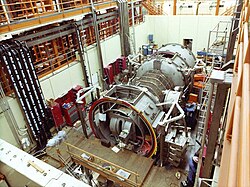| Tandem Mirror Experiment | |
|---|---|
 The Tandem Mirror Experiment (TMX) in 1979 | |
| Device type | Magnetic mirror |
| Location | Livermore, California, U.S. |
| Affiliation | Lawrence Livermore National Laboratory |
| History | |
| Date(s) of construction | 1977 – 1979 |
| Year(s) of operation | 1979–1987 |
| Preceded by | 2XIIB |
| Related devices | Mirror Fusion Test Facility (MFTF) |
The Tandem Mirror Experiment (TMX and TMX-U) was a magnetic mirror machine operated from 1979 to 1987 at the Lawrence Livermore National Laboratory.[1] It was the first large-scale machine to test the "tandem mirror" concept in which two mirrors trapped a large volume of plasma between them in an effort to increase the efficiency of the reactor.
The original TMX was designed and built in a short period between its conception at a major physics meeting in Germany in October 1976, its design in January 1977, and its completion in October 1978. Over the next year, it validated the tandem mirror approach. Plans began to build a much larger machine based on the same principles, the Mirror Fusion Test Facility (MFTF). MFTF was initially just a scaled-up version of TMX, but when the design was studied it was seen that it would not reach its desired performance. Some system was needed that would boost the internal temperature of the fuel.
A solution was found in the form of "thermal barriers" which would trap high-energy electrons and allow the fuel to be increased in energy without increasing leakage. MFTF was modified to add barriers and became MFTF-B. While construction on MFTF-B began, thermal barriers were added to TMX to become TMX-U in 1982. While TMX-U validated the concept in general, the thermal barriers were not stable. MFTF-B was almost complete by this time, and funding was cancelled the day after its completion. TMX-U continued to operate until February 1987.
- ^ Booth, William (1987). "Fusion's $372-Million Mothball". Science. 238 (4824): 152–155. Bibcode:1987Sci...238..152B. doi:10.1126/science.238.4824.152. PMID 17800453.